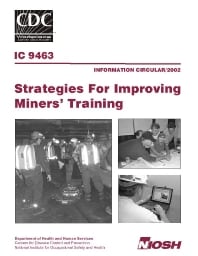Mining Publication: Principles of Adult Learning: Application for Mine Trainers
Original creation date: September 2002
Authors: KM Kowalski, C Vaught
NIOSHTIC2 Number: 20022094
In: Peters R, ed. Strategies for Improving Miners' Training. Pittsburgh, PA, U.S. Department of Health and Human Services, Public Health Service, Centers for Disease Control and Prevention, National Institute for Occupational Safety and Health, DHHS (NIOSH) Publication No. 2002-156, Information Circular 9463, 2002 Sep :3-8
Safety and health professionals from all sectors of industry recognize that training is a critical element of an effective safety and health program. A major concern in the mining industry is how to train both an aging workforce and the expected influx of new miners and mine managers as older workers retire. Thus, a review of some of the basic principals of adult learning may be helpful to mine trainers. This paper discusses the principals of adult learning based on research in education and psychology. It stresses the importance of taking a systems approach to training, focusing on the relationship between the environment and technology, and understanding how workers interact with both. The authors argue that the principals of adult learning and a systems approach are fundamental to the delivery of effective training in the mining industry. Examples of training programs developed by the Pittsburgh Research Laboratory of the National Institute for Occupational Safety and Health are presented within two broad performance domains: routine and nonroutine skills. Basics of curriculum development are also briefly presented to provide the mine trainer with a template for program development.

NIOSHTIC2 Number: 20022094
In: Peters R, ed. Strategies for Improving Miners' Training. Pittsburgh, PA, U.S. Department of Health and Human Services, Public Health Service, Centers for Disease Control and Prevention, National Institute for Occupational Safety and Health, DHHS (NIOSH) Publication No. 2002-156, Information Circular 9463, 2002 Sep :3-8
- Developing Toolbox Training Materials for Mining
- Education and Training
- Guidelines for the Development of a New Miner Training Curriculum
- An Ounce of Prevention: Training Workers to Prevent a Crisis
- Strategies for Improving Miners' Training
- Technology News 537 - NIOSH Develops New Mine Refuge Chamber Training
- Tell Me a Story: Using Stories to Improve Occupational Safety Training
- Tell Me a Story: Why Stories are Essential to Effective Safety Training
- Underground Coal Mine Disasters 1900-2010: Events, Responses, and a Look to the Future
- Working in the Classroom - A Vision of Miner Training in the 21st Century